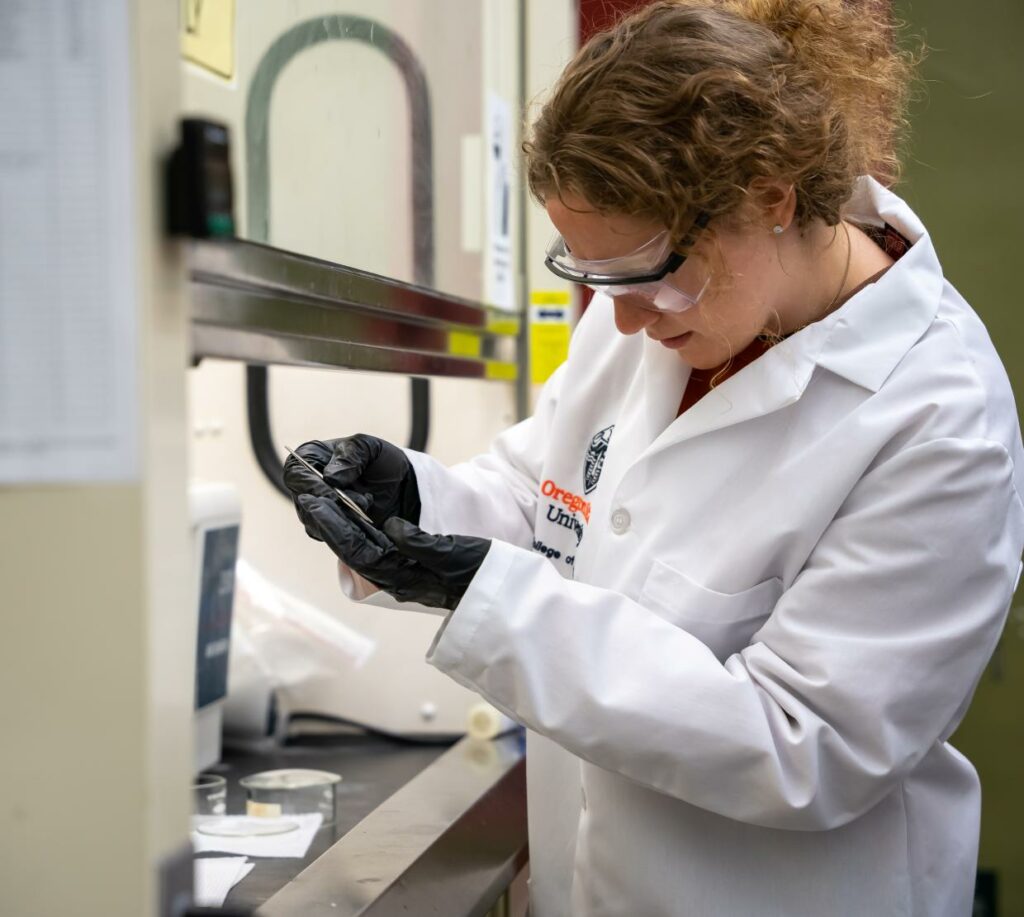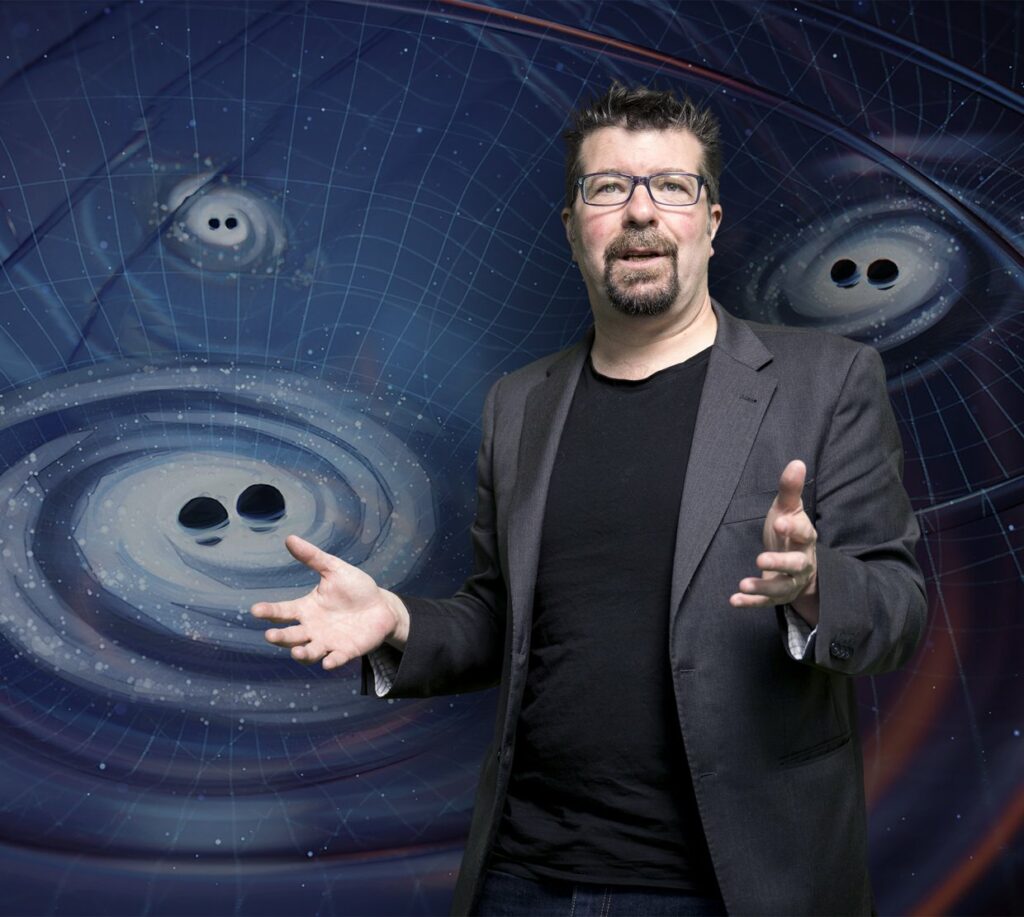The College of Science Impact blog has a post by Elana Roldan about recent graduate and Goldwater Scholar Madalyn Gragg


The College of Science Impact blog has a post by Elana Roldan about recent graduate and Goldwater Scholar Madalyn Gragg

Reprinted from an Impact post by Hannah Ashton on January 17, 2025

Xavier Siemens, a renowned astrophysicist and professor at Oregon State’s College of Science, has been awarded the prestigious 2025 Bruno Rossi Prize, one of the highest international honors in high-energy astrophysics, for his groundbreaking work uncovering evidence of binary supermassive black holes.
Siemens shares the honor with Maura McLaughlin and the North American Nanohertz Observatory for Gravitational Waves (NANOGrav) Physics Frontiers Center whose achievement in gravitational wave research marks a significant step forward in understanding the dynamics of the Universe and its deep mysteries.
In June 2023, Siemens led an international team of nearly 200 researchers, including OSU students, in detecting low-frequency gravitational waves reverberating across the universe—ripples in spacetime first predicted by Albert Einstein over a century ago. This discovery provided the first direct evidence of the stochastic gravitational wave background, caused by merging binary supermassive black holes.
NANOGrav announced their groundbreaking discovery in June 2023. The news was picked up around the world including by the New York Times, Nature, Reuters, AP News, The Guardian, The Washington Post, BBC, NPR and more.
“We are incredibly proud of Dr. Siemens,” said Dean Eleanor Feingold. “The Bruno Rossi Prize is one of the most prestigious honors in high-energy astrophysics and places him among the world’s leading scientists. His groundbreaking achievements continue to inspire his students, who pursue the universe’s most profound questions with his mentorship.”
Presented annually by the High Energy Division of the American Astronomical Society, the Bruno Rossi Prize recognizes exceptional contributions to high-energy astrophysics. Awarded since 1985, this prize is highly regarded in the astrophysics community, often highlighting work that pushes the boundaries of our understanding of the universe. The award will be formally presented at the next HEAD meeting, where Siemens and his collaborators will deliver a lecture on their findings.
Siemens’ achievements not only advance the field of astrophysics but also inspire the next generation of scientists, including graduate and undergraduate students at Oregon State, where he continues to mentor and conduct research that pushes the boundaries of human knowledge.
A physics-engineering double major senior, Vincent received a Summer Computational Physics Fellowship from Los Alamos National Lab. Vincent’s senior thesis advisor Rebecka Tumblin said Vincent was a brilliant and motivated physicists/programmer.
Brandon Brown (Ph.D., 1997, Tate group) recently published, “Sharing our Science: How to Write and Speak STEM,” (2023, MIT Press). For more details, see https://mitpress.mit.edu/9780262546959/sharing-our-science/; the book is already garnering great reviews! Brown is Professor of Physics at the University of San Francisco. This is his 3rd book, following a biography of Max Planck and a history of the Apollo Project from the perspective of its engineers. Prof. Brown will visit OSU Physics in Spring 2024 to share his ideas on science communication in our colloquium series.
For International Women’s Day, I’m reposting a history of one of our most distinguished alumni, Dr. Chung Kwai Lui. Dr. Lui was the first woman to receive a doctorate in any field from OSU and was nationally recognized for her work on the Manhattan project and at Westinghouse on phosphor development. The Wei Family Private Foundation has established a scholarship in honor of her and her husband Hsin Hsu Wei.
This was originally posted on our website as OSU’s First Woman Physics PhD by Ken Krane.
There is more information about Dr. Lui and legacy provided by the Wei Family Private Foundation in this article from the College of Science.

Chung Kwai Lui was born in Canton, China in 1909. In 1929, she enrolled at Lingnan University, which had been established as a Christian college in 1888 by American missionaries in Guangzhou. The reputation of the college grew quickly, and by 1918 the leading U.S. universities, including Harvard, Yale, and Stanford, were accepting its students for graduate programs. Miss Lui chose physics as her major and completed her undergraduate degree in 1933. In addition to the regular curriculum of physics courses, she also took courses in science teaching, and from 1933 until 1936 she taught physics at the middle-school level. At the same time she enrolled in graduate courses in physics at Lingnan University.
In 1936, the Oregon State chapter of Phi Kappa Phi (an academic honor society) offered Miss Lui an exchange scholarship, which covered her tuition and room. She moved into Snell Hall, which was then a women’s dormitory. She was one of thefirst two students to enroll in the newly formed physics graduate program at Oregon State. Within one year, she had completed and defended her M.S. thesis, Diffusion Phenomena in Strong Magnetic Fields, under the supervision of Professor Willibald Weniger, who was also chair of the Physics Department. Her experimental work studied the magnetic field and temperature dependence of the time for the diffusion of aqueous dye solutions. She continued on to study for a Ph.D. inphysics, which she completed in 1941 under the supervision of Professor James Brady. Her thesis, The Crystal Photoeffect in D-Tartaric Acid Single Crystals, concerned a process analogous the better-known photoelectric effect in metals, in which light shining on certain crystals causes a current to flow. She immediately published her Ph.D. thesis work in the Physical Review, the leading U.S. journal of physics research, as a single-authored paper (vol. 60, pages 529-531).
Following the completion of her Ph.D. she taught as an instructor at Oregon State for several years, and then she was hired by the Westinghouse Lamp Research Laboratory in New Jersey, where she studied phosphors and fluorescent lamps. Westinghouse was also investigating materials for possible use as filaments in incandescent lighting, among which was uranium. So during the Manhattan Project, which was the highly secret U.S. effort to develop the atomic bomb during World War II, the Westinghouse expertise in purifying microscopic quantities of uranium was instead applied to kilogram quantities, and Dr. Lui turned her skills to that project.
Although she had originally entered the U.S. on a student visa, which would normally have required her to return to China to apply for admission as a permanent resident (the path to citizenship), the U.S. government did not want her knowledge of the atomic research program to fall into the hands of the Communist Party, which had taken over control of China. So in 1949 the Congress passed, and President Harry Truman immediately signed, a bill “for the relief of Doctor Chung Kwai Lui,” which read in part “the Attorney General is authorized and directed to record Dr. Chung Kwai Lui as having entered the United States in 1936 for permanent residence.” This bill in effect retroactively changed the status under which she had entered the U.S. and thus permitted her to stay. Also in 1949 she married Mr. Hsin Hsu Wei, who had emigrated from China after the war, received a master’s degree in electrical engineering from Columbia University, and also was employed by Westinghouse.
Dr. Chung Kwai Lui Wei remained at Westinghouse, mostly doing research into the properties of phosphors, until she retired in 1974. She published several papers in physics journals on her work with phosphors, and she is the holder of 2 patents, one in the U.S. and the other in Canada. She died in 2008 at the age of 98. She and her husband (who died in 2000) recognized the value that higher education had played in their lives, and they left their estate to establish the Wei Family Private Foundation, which supports scholarships for students of Chinese ancestry who are studying engineering or science at Oregon State or electrical engineering at Columbia. This wonderful legacy will continue to provide support for students at OSU who hope to follow the exemplary path established by the first woman to earn a physics Ph.D. at Oregon State.
Emeritus Professor of Physics Kenneth Krane and his wife, Paula, are recipients of this year’s Distinguished Service Award from the OSU College of Science for the many scholarships and endowments the couples have made to support students across the university. Read more at https://science.oregonstate.edu/impact/2022/10/distinguished-service-award-supporting-experiential-learning
Dr. Esfahani successfully defended his thesis: Three-dimensional cancer cell migration under mechanochemicalguidance
Congratulations!
Dr. Walsh received College of Science Faculty Scholar award for recognition of his exceptional contributions to his discipline and Oregon State University. This is a three-year titled endowed position. See more details at https://internal.science.oregonstate.edu/faculty-and-staff-awards/college-science-whiteley-faculty-scholar-teaching-excellence-award-and-osu
Nima Laal received 2022-2023 Larry W. Martin & Joyce B. O’Neill Endowed Fellow in the College of Science.
Isak McGieson received DOE Graduate Student Research (SCGSR) program award.
Congratulations to both!